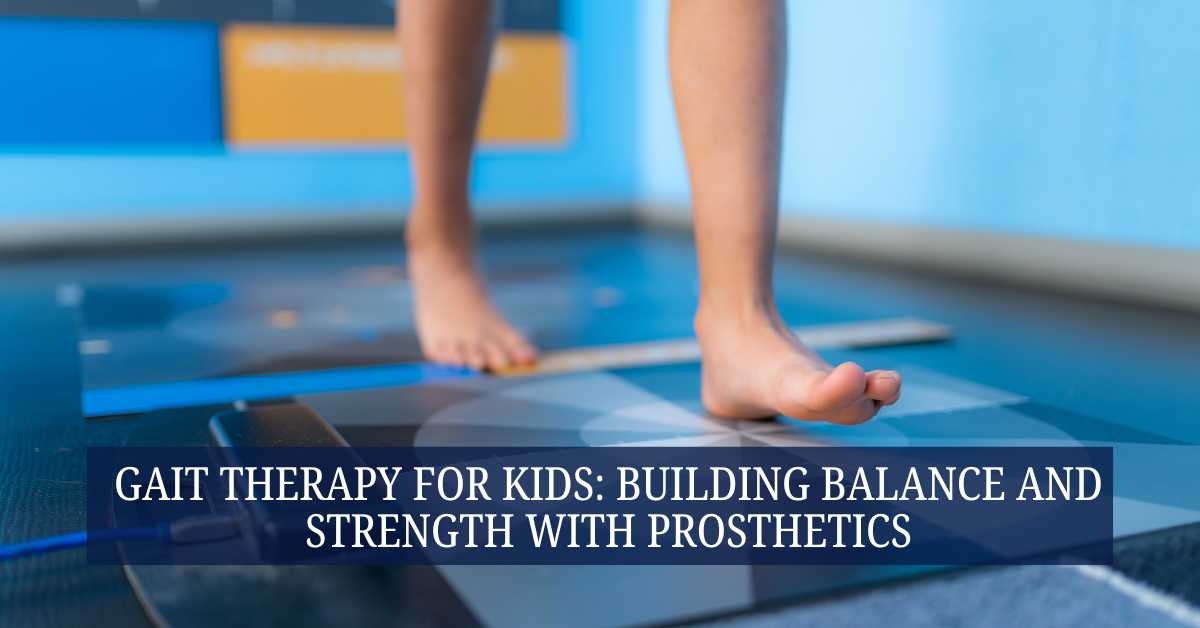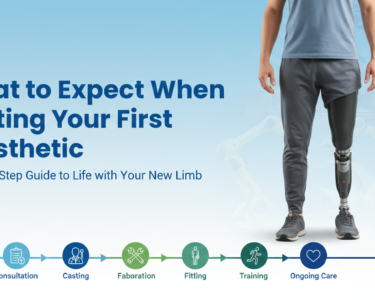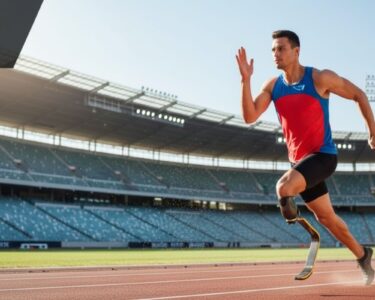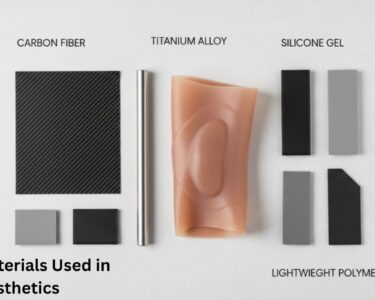Watching a child take their first steps is one of the most memorable moments for any parent. But for children using prosthetic limbs, learning to walk comes with its own set of unique challenges—and incredible triumphs. That’s where gait therapy comes in.
Gait therapy is more than just learning to walk—it’s about helping children gain confidence, balance, and independence as they adapt to life with a prosthetic limb. Whether a child is born with a limb difference or has experienced an amputation, gait training provides the tools and support they need to move forward—literally and emotionally.
In this article, we’ll explore what gait therapy really means for kids, how it works, and why it’s such a vital part of pediatric prosthetic care. With the right guidance and support, every child has the potential to build strength, improve mobility, and walk toward a brighter future.
What is Gait Therapy and How Does it Help Children with Prosthetics?
Understanding the Basics of Gait Therapy
Gait therapy is a type of physical therapy that focuses on helping individuals learn how to walk correctly and safely. For children, especially those using prosthetic limbs, gait therapy is an essential part of their rehabilitation journey. It involves guided training sessions where a physical therapist helps the child practice walking in a way that promotes balance, coordination, and proper posture.
The term “gait” simply refers to the way a person walks. After an amputation or when a child is born with a limb difference, the way they move is naturally different. Gait therapy teaches them how to adjust to their prosthetic limb and develop a walking pattern that feels more natural and comfortable.
During gait therapy, the therapist carefully observes the child’s movements and may use tools like parallel bars, treadmills, or supportive harnesses to provide stability and safety. They also guide the child through specific exercises that strengthen muscles, improve flexibility, and train the brain to adapt to the new way of walking.
Why Gait Therapy Is Essential in Pediatric Prosthetic Rehab?
Gait training is more than just learning how to walk—it’s about helping children feel confident, strong, and independent as they adjust to life with a prosthetic limb. When a child loses a limb due to injury or is born with a limb difference, their walking pattern, balance, and posture are affected. This is where gait training becomes incredibly important.
Children’s bodies are still growing, and without proper guidance, they may develop habits like limping, leaning too much on one side, or dragging their foot. These patterns can lead to long-term issues like joint pain, muscle strain, or difficulty with future movement. Gait training corrects these problems early by teaching the child how to walk in a healthy, balanced way with their prosthetic.
Through guided practice and supportive exercises, gait training helps children improve strength in their legs, hips, and core muscles. It also enhances their coordination and teaches them how to trust their prosthetic limb. This process reduces the risk of falls and helps them become more independent in daily life—whether it’s climbing stairs, playing at school, or simply walking around the house.
More importantly, gait training gives children emotional confidence. Many kids feel unsure or frustrated when they first begin using a prosthetic. Working with a trained therapist who encourages them and celebrates their progress can make all the difference in how they view their abilities. Instead of feeling limited, they start to believe in themselves and look forward to new achievements.
At What Age Can a Child Start gait Training with a Prosthetic Limb?
Children can usually begin gait training as soon as they are medically stable and fitted with their prosthetic limb. In many cases, this can be as early as 18 to 24 months, especially for children who were born with limb differences or experienced early amputations.
Age isn’t the only factor. Therapists also consider the child’s physical development, strength, coordination, and emotional readiness. For older children who undergo amputations due to illness or injury, gait training may begin shortly after healing from surgery and receiving the prosthetic device.
The key is to start early enough to allow children to integrate walking naturally into their development, but not so early that it becomes overwhelming. Early intervention also helps them adjust to using a prosthetic limb as a normal part of their daily life.
Factors That Determine the Right Age for Gait Training
Determining the right age for a child to begin gait training with a prosthetic limb isn’t always about a specific number—it’s about the child’s unique development, readiness, and physical needs. Every child is different, and several important factors help professionals decide when gait therapy should begin.
One key factor is the child’s overall physical development. Therapists and doctors look at whether the child has reached certain milestones, like being able to sit up without support, crawl, or stand with help. These early signs show that their muscles and coordination are developing, making them more prepared for the challenges of walking.
Another major consideration is how soon a prosthetic limb can be safely and comfortably fitted. Some children, especially those with congenital limb differences, may be fitted with a prosthetic limb as early as 9 to 12 months old—around the time most children begin standing or trying to walk. Early fitting allows the child to grow up using the prosthetic as part of their everyday life, which often makes the adjustment process smoother.
How Early Intervention Supports Development
Early intervention in gait training plays a powerful role in a child’s overall development, especially when they are learning to walk with a prosthetic limb. When therapy begins at a young age, children have a better chance of developing strong, balanced movement patterns that feel natural and comfortable. This early start doesn’t just help them walk—it lays the foundation for how they move, play, and interact with the world around them.
One of the biggest benefits of early intervention is that it takes advantage of a child’s natural ability to learn quickly. Young children’s brains are highly adaptable—a quality known as neuroplasticity. This means they can more easily form new movement patterns and adjust to using a prosthetic limb. By starting therapy early, we help their brain and body grow together in harmony, which leads to smoother, more confident mobility as they age.
How long does it take for children to learn to walk with prosthetics?
There’s no single timeline that fits every child. The learning curve depends on several factors:
- The child’s age and development stage
- Type and level of amputation (e.g., above-knee vs. below-knee)
- Physical strength and balance before starting therapy
- Type and fit of the prosthetic limb
- Frequency and consistency of therapy sessions
- Emotional and psychological readiness
For some children, walking with a prosthetic may take a few weeks to a few months of consistent gait training. Others may need ongoing therapy for a year or more, especially if additional surgeries or prosthetic adjustments are needed over time.
The focus should be less on how fast the child learns and more on building solid walking habits, confidence, and strength. Celebrating small milestones—like standing independently or taking a few steps—is important motivation along the journey.
What Influences the Speed of Progress in Gait Training
Every child learns to walk with a prosthetic limb at their own pace, and the speed of progress during gait training can vary greatly depending on several important factors. Understanding these influences can help parents and caregivers manage expectations and support their child’s journey with patience and positivity.
One of the biggest factors is the child’s age and developmental stage. Younger children often adapt more quickly to using a prosthetic because their bodies are still learning basic motor skills like balance, coordination, and walking. Their brains are more flexible, making it easier to build new movement patterns. On the other hand, older children who are already used to walking a certain way before limb loss may need more time to adjust to a prosthetic.
The type of amputation or limb difference also plays a role. For example, a child with a below-knee (trans-tibial) prosthetic may learn to walk faster than a child with an above-knee (trans-femoral) prosthetic because below-knee prosthetics are typically easier to control and allow more natural movement. Similarly, a child born with a limb difference may have a different timeline than one who received a prosthetic after surgery or trauma.
Another major factor is the child’s overall health and physical condition. Strong core muscles, good posture, and flexibility all support quicker progress in gait training. Children who have additional physical or neurological conditions may need more time and a more customized therapy plan to meet their unique needs.
Why Patience and Consistency Matter in Prosthetic Walking
Learning to walk with a prosthetic limb is not something that happens overnight—especially for children. It’s a process that takes time, practice, encouragement, and above all, patience. While every child’s journey is unique, one thing remains true across all cases: consistent effort and a patient mindset are key to long-term success.
For many children, adjusting to a prosthetic limb involves more than just learning to walk. They must get used to how the prosthetic feels on their body, how it moves, and how it responds. This can be physically tiring and emotionally overwhelming at first. Some days may feel like a big leap forward, while others might seem like a step back. That’s completely normal. And it’s why patience is essential—not just from the child, but from parents, therapists, and caregivers too.
A rushed approach can lead to frustration and even setbacks. If a child feels too much pressure to “walk normally” too soon, it may reduce their confidence or cause anxiety during therapy. But when adults show patience and understanding, the child feels safe and supported. They learn it’s okay to take their time, to stumble, and to try again. This helps them stay motivated and emotionally strong, which is just as important as physical ability.
What exercises are involved in pediatric gait therapy?
Pediatric gait therapy involves a wide range of fun, age-appropriate exercises that help children improve their strength, flexibility, balance, and coordination. These exercises are usually designed like games or playful activities to keep young minds engaged while training the body.
Here are a few common exercises and techniques:
- Balance Training: Using wobble boards, foam pads, or standing on one leg to help develop control and stability.
- Strengthening Drills: Simple bodyweight exercises like squats, step-ups, and leg lifts to strengthen hip, thigh, and core muscles.
- Walking Practice: Walking on different surfaces (grass, carpet, ramps) to simulate real-life environments.
- Obstacle Courses: Designed to help with stepping over or around objects, encouraging quick decision-making and spatial awareness.
- Mirror Walking: Children walk in front of a mirror to visually correct their posture and step patterns.
- Treadmill Training with Harnesses: Allows therapists to guide walking motion safely while reducing weight-bearing pressure.
Every exercise is adapted to the child’s age, type of prosthetic, and comfort level.
Can gait therapy improve a child’s balance and posture?
Yes, gait therapy is specifically designed to improve both balance and posture, which are often affected after limb loss or prosthetic fitting.
When a child starts using a prosthetic limb, their body mechanics shift. For instance, they may lean to one side, walk unevenly, or develop poor posture due to overcompensation. Without therapy, these patterns can lead to chronic pain, muscle imbalances, or even long-term issues with the spine or joints.
Gait therapy helps correct these problems by:
- Training proper weight distribution
- Teaching how to stand and walk symmetrically
- Strengthening the muscles that support upright posture
- Improving core stability, which is essential for maintaining balance
The result is smoother, more efficient movement—and a reduced risk of falls or injuries.
How often should a child attend gait training sessions?
The frequency of gait training sessions depends on the child’s needs, goals, and overall health, but in general, therapy may be scheduled:
- 2 to 3 times per week for active, early-stage training
- Once a week or bi-weekly for ongoing support or long-term progress tracking
- Intensive programs with daily sessions (usually for a few weeks) in some specialized pediatric rehab centers
As the child gains confidence and control, the frequency may be reduced. But consistency is key, especially in the beginning. Therapists also provide at-home exercises that parents can help with to keep the progress going between sessions.
Are there different gait therapy approaches for above-knee and below-knee prosthetics?
Yes, gait therapy is customized based on the type and level of amputation—because the physical demands vary greatly.
- Below-Knee (Transtibial) Prosthetics: These children retain their knee joint, which makes it easier to maintain natural walking motion. Therapy focuses on ankle movement, foot placement, and balance training.
- Above-Knee (Transfemoral) Prosthetics: These cases are more complex because the knee joint is also artificial. Therapists focus on helping the child learn how to control the prosthetic knee, stabilize the hip, and prevent falls during steps.
Each type of prosthetic affects muscle use, balance, and coordination differently, so therapists create personalized training plans for each child.
What role do parents play in supporting gait therapy at home?
Parents play a vital role in their child’s gait therapy journey, often making the biggest difference in how well the child progresses. What happens outside the therapy sessions is just as important as the work done with the therapist. At home, parents can help by practicing recommended exercises regularly, turning therapy into a fun and natural part of daily life.
Encouraging the child to move around frequently—whether it’s walking through the house, playing outside, or even climbing stairs—helps build strength and confidence. Celebrating small milestones, like successfully walking a few steps or putting on the prosthetic independently, boosts the child’s motivation and self-esteem.
Parents’ positive attitude is also crucial, as children often pick up on their caregiver’s emotions, so staying encouraging and patient can make a huge difference. Additionally, parents assist by taking care of the prosthetic itself, ensuring it fits well, stays clean, and reporting any problems to the prosthetist promptly.
Keeping open communication with therapists is important too, as it helps parents stay informed about their child’s progress and learn new ways to support at home. Simply put, the more involved and supportive the family is, the more successful the child’s gait training will be.
Parental Tips for Supporting Prosthetic Care and Therapy
Parents play an essential role in supporting both the care of their child’s prosthetic and the success of gait therapy. Proper prosthetic care starts at home, where parents can help ensure the device fits comfortably and stays clean.
Regularly checking for any signs of wear, irritation, or discomfort allows parents to catch problems early and communicate them to the prosthetist. Beyond the physical care of the prosthetic, parents can support therapy by encouraging consistent use of the device throughout the day, making walking practice a fun and regular part of daily routines.
It’s important to celebrate even the smallest achievements to keep the child motivated and build their confidence. Additionally, maintaining open and frequent communication with therapists helps parents stay informed about progress and learn new techniques to practice at home. By combining attentive prosthetic care with active involvement in therapy, parents create a nurturing environment where their child can thrive and gain independence step by step.
Communicating Effectively with Therapists as a Parent
Clear and open communication between parents and therapists is a key part of successful gait therapy for children using prosthetics. Parents are the child’s biggest advocates and can provide valuable insights about how their child is doing outside of therapy sessions—whether they notice any discomfort, frustration, or progress during daily activities.
Regularly sharing this information helps therapists adjust the therapy plan to better fit the child’s needs. It’s also important for parents to ask questions, seek advice on exercises or care, and be honest about any challenges they face at home.
By building a trusting and collaborative relationship with therapists, parents ensure their child receives the most effective support possible. This teamwork creates a strong foundation where the child feels encouraged and understood, leading to better outcomes in their gait training journey.
How do therapists track progress during gait training?
Therapists use a combination of observation, measurement, and feedback tools to track a child’s progress. These may include:
- Video analysis to review walking patterns and posture over time
- Gait assessment tools like pressure-sensitive walkways or motion capture systems
- Range of motion and strength tests to measure improvements in flexibility and muscle control
- Walking distance and endurance tracking (e.g., how far the child can walk unassisted)
- Balance tests to see how well the child can stand or move without support
Progress is also tracked based on goals set at the start of therapy—like walking independently, using stairs, or walking outdoors. These milestones help parents and therapists know when to adjust the therapy plan or celebrate a new achievement.
How Therapists Adjust Plans Based on a Child’s Progress
Gait training isn’t a one-size-fits-all process—especially when working with children who are learning to walk with prosthetics. Every child is unique, with different abilities, needs, and comfort levels. That’s why therapists closely monitor each child’s progress and make personalized adjustments to their training plan along the way. These adjustments are key to helping the child move forward safely, confidently, and effectively.
In the early stages of therapy, the focus might be on helping the child become familiar with their prosthetic limb—learning how it feels, how to put it on, and how to move with it. But as the child begins to master basic movements, the therapist gradually introduces new challenges. These might include practicing on uneven surfaces, walking longer distances, or improving speed and balance. The timing of these changes depends entirely on how the child is doing—not just physically, but emotionally as well.
Therapists use a combination of observation and formal assessments to decide when to make changes. They watch how the child walks: Are their steps becoming smoother? Is their balance improving? Are they relying less on assistive devices? They also listen to the child’s feedback. If a child feels discomfort, fatigue, or fear, the therapist may slow down or revisit earlier exercises until the child is ready to move forward.
Another important consideration is growth and development. As children grow, their bodies change—and so must their prosthetic limbs and therapy routines. Therapists stay alert for signs that a prosthetic may no longer fit well or that the child needs a different type of support. They may collaborate with prosthetists to make adjustments or provide referrals for new fittings.
In some cases, therapists may also tailor the therapy to match the child’s personal goals. For instance, if a child wants to play sports or join a dance class, therapy may include specific exercises to improve agility, flexibility, or endurance. This kind of goal-oriented training can boost motivation and make therapy feel more rewarding and fun.
Therapists also work closely with parents and caregivers, updating them on progress and suggesting ways to support the child at home. This might involve simple home exercises, reminders to wear the prosthetic daily, or encouragement to keep practicing even on tough days. By aligning therapy with the child’s real-life needs and environment, progress becomes more meaningful and lasting.
In short, therapists don’t just follow a checklist—they respond to the child in real time. They make thoughtful adjustments that keep therapy both challenging and achievable. This flexible, responsive approach helps children continue moving forward with confidence, building not just strength and balance, but also the courage to keep going.
Tools and Techniques Used to Measure Improvement
Tracking progress in pediatric gait therapy is a thoughtful and structured process. Therapists use a variety of tools and techniques to evaluate how well a child is learning to walk with a prosthetic limb. These tools help ensure that therapy is working effectively and that any necessary adjustments can be made in a timely and personalized way.
One of the most common tools used is video analysis. Therapists often record a child walking during sessions and then review the footage frame by frame. This allows them to closely examine things like step length, knee movement, body posture, and how evenly the child is distributing their weight. Video comparisons over time can show subtle improvements or highlight issues that need to be addressed. It’s also a great visual tool to show children and their parents how far they’ve come.
Another widely used technique is gait assessment scales. These are standardized checklists or scoring systems that rate different aspects of walking. For example, therapists might use the Observational Gait Scale (OGS) or the Pediatric Gait, Arms, Legs, and Spine (P-GALS) tool. These help track details like symmetry, limb motion, and foot placement. By assigning scores to each area, therapists can clearly track improvements from one session to the next.
Wearable motion sensors and pressure mats are also becoming more common in modern clinics. These tools provide objective data on how a child’s body moves during walking. For example, pressure mats can show whether a child is placing more weight on one foot than the other, or if their balance shifts suddenly. This type of data can be very helpful for customizing exercises and tracking even small changes in walking patterns.
Therapists also rely on timed walking tests, like the “10-Meter Walk Test” or “6-Minute Walk Test.” These help measure how quickly and confidently a child can move across a space or how far they can walk without stopping. These tests aren’t just about speed—they show how much strength, stamina, and coordination a child has built up over time.
Besides physical measurements, therapists often track functional goals and emotional progress. For instance, they’ll note if a child has started walking in new environments, like at school or the park, or if they’ve become more willing to try walking without support. Therapists also check in on how the child feels—Are they more confident? Less afraid of falling? These emotional markers are just as important as physical milestones.
Finally, therapists keep detailed progress reports for each child. These include notes from each session, results from any tests, videos or photos, and plans for future goals. These reports are shared with the child’s medical team and family to make sure everyone is on the same page and working together to support the child’s journey.
Every Step Forward Matters
Gait therapy is more than just teaching a child how to walk—it’s about giving them the freedom to move, explore, and grow with confidence. For children using prosthetics, each session is a step toward independence, improved strength, and a better quality of life. With the help of skilled therapists, supportive families, and the right tools, kids can overcome physical challenges and develop the balance, coordination, and resilience they need to thrive.
The journey may take time, and progress might look different for every child, but what matters most is that each step is filled with encouragement, adaptation, and care. From early intervention to tracking every milestone with precision, gait therapy is a personalized path that puts the child at the center of their own success story. And with patience, teamwork, and determination, children with prosthetics can achieve incredible things—one confident step at a time.
Disclaimer: The information provided in this article is for general knowledge and educational purposes only. It should not be considered medical advice, diagnosis, or treatment. Prosthetic solutions vary based on individual needs, medical conditions, and professional recommendations. Always consult with a certified prosthetist, healthcare provider, or medical professional for personalized advice and the best prosthetic options for your specific situation.








